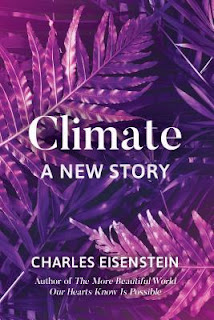Book Review: “Climate – A New Story” by Charles Eisenstein (2018)
Peter Glynne-Jones reviews this different 'take' on the climate problem. Charles Eisenstein uses Thich Nhat Hanh's term 'interbeing' to explore how humankind needs a radically different relationship with the world around us.
Charles Eisenstein writes eloquently and delves into the root causes of climate change and of the rapid decline of our ecosystems. He steps beyond blame to illuminate fresh perspectives, giving hope and seeds for change. The book is a pleasure to read and speaks for a love of the rich and diverse web-of-being of the [natural] world.
I remember Ven. Myokyo-ni saying that one of the things that drew her to Buddhism was questioning what it was that allowed mankind to clearly see the extinction that met the dinosaurs and yet seem to follow a similar course despite our rational and scientific knowledge. Eisenstein does not profess to be a Buddhist, and yet his description of the problems we face has some familiarity.
The prologue draws a picture of a person trapped in a maze, lost and hopeless. Later he comments:
“That moment of humble, powerless unknowing, where the sadness of an ongoing loss washes through us and we cannot escape into facile solutioning, is a powerful and necessary moment. It has the power to reach into us deeply enough to wipe away frozen ways of seeing and ingrained patterns of response. It gives us fresh eyes, and it loosens the tentacles of fear that hold us in normality...”
Eisenstein sees our cultures to be trapped in a story of “Separation”. Viewing the rest of the world as “Other” the stage is set for fear, conflict, and a greedy abuse of the bounty of nature.
“In the case of ecocide, the mentality of war is not only an obstacle to healing, it is an intimate part of the problem. War is based on a kind of reductionism: it reduces complex interconnected causes - that include oneself - to a simple, external cause called the enemy. Furthermore, it normally depends on the reduction of the enemy to a degraded caricature of a human being. The demonization and dehumanization of the enemy is little different from the desacralization of nature upon which ecocide depends. To render nature into an ‘other’ undeserving of reverence and respect, an object to dominate, control, and subjugate, is of a kind with the dehumanization and exploitation of human beings.”
He traces the problem all the way back to the Neolithic, but also spends time showing how it is embodied in the modern world. He borrows the term “Interbeing” from Thich Nhat Hahn to describe an alternative story where nothing has independent existence but exists in complex inter-relation to everything else. And here is some of the hope: that every action we make is connected in immensely subtle ways to the movement of the whole.
“Interbeing must be more than a philosophical concept if anything is going to change. It must be a way of seeing, a way of being, a strategic principal, and most of all a felt reality. Philosophical arguments alone will not establish it any more than appeals to prudence and reason or solve the ecological crisis.”
Eisenstein devotes time to showing how our current response to the environmental crisis is warped by our propensity to objectify and measure nature. For example, in the drive for zero-carbon it becomes acceptable to destroy ancient ecosystems of inconceivable complexity to build dams and offset them by tree planting elsewhere. With careful research he shows the short-sightedness of such actions and the blindness that comes from reducing nature to a few measurable quantities. We need, he says, to shift to a perspective where the earth is revered as sacred, and to value forests, grasslands, wetlands, etc. for their inherent worth as beings. For Eisenstein the earth is a living being, and it is out of a deeper experience of this that he sees a healthier relationship emerging.
In places Eisenstein states his opinion on various controversial theories. The reader may or may not agree with them, but that is not important to the central messages of the book. In fact, he highlights our propensity to polarized debate as a part of the story of “Separation”. A chapter on the global warming debate seeks to understand the extremes of those involved and avoid demonising those that are seen to obstruct “progress” in whatever form that is pictured. Instead, he suggests that rather than focussing on abstract measures – like carbon and climate data – that we can only appreciate through the mediation of the professional class of scientists, we could focus on our love of nature. That those of us that have been touched by our own local experience of woodland or estuary will have the commitment to work to protect them, and the patience to listen to their needs at the individual level.
The book does not offer easy solutions and frames our situation as an initiatory crisis from which new life must spring. It acknowledges that we cannot regress to our pre-industrial ways, yet must also be open to learning from indigenous peoples that have not lost their connection to the land. How can our technologies and ways of living be transformed from exploiting the earth to ones that can serve it?
Reading the book, one was reminded afresh of the value of Buddhist practice and the contribution that devotion makes to this world. By practising an ancient tradition rooted in “interbeing” we embody and carry forward the precious seeds of a relationship to the world as sacred. By living those traditions in our modern setting, we give them life and let them adapt to a form that fits our times. We turn over the merit to all beings.
...
Text copyright to Peter Glynne-Jones



Comments
Post a Comment